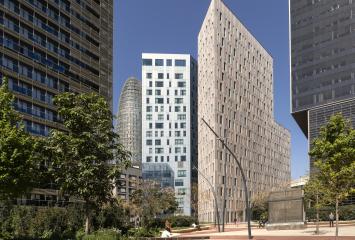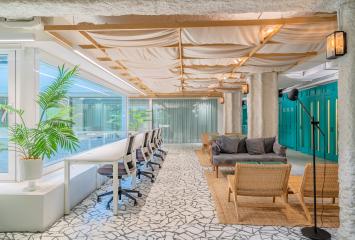How to harness the benefits of artificial lighting
One of the keys to sustainability in office buildings, as demonstrated by all the assets we have in Colonial both in Barcelona and Madrid, is the use of natural light. On the one hand, because it is a type of light that is inherent to human beings and, therefore, much more pleasant for workers. Its proper flow improves their emotional health and professional performance. On the other hand, because natural light doesn’t consume the planet’s resources. However, there are many circumstances where artificial lighting is essential for the proper functioning of business activities within the office. This is where knowing how to take advantage of its benefits becomes crucial.
Types of artificial lighting
One of the most important decisions regarding artificial lighting is probably the choice of light bulbs. LED bulbs, for example, represent the most energy-efficient option and are therefore the most recommended for visibility in dark situations without causing excessive pollution. They also have a long lifespan, are available in a wide range of color temperatures, and are highly decorative. Fluorescent bulbs, and especially incandescent bulbs, are less energy efficient. The latter, in particular, consumes 80% more energy than LED bulbs and lasts up to 25 times less.
Distribution of artificial lighting
Another important aspect for making the most of artificial light is the placement of lamps. Poor distribution can lead to the need for more lamps to illuminate every corner, which increases energy consumption. A strategic approach is needed, considering general lighting for visibility and safety, task lighting for work functions, and accent lighting for decorative and branding elements. Task lighting should ideally have customizable adjustment mechanisms, while accent lighting should be used sparingly.
Color temperature of artificial lighting
Humans can perceive different wavelengths of light within the visible spectrum, and we maintain an emotional relationship with each type of light. Warm white, for instance, conveys relaxation and inner peace, making it ideal for rest areas. Neutral white, on the other hand, is perfect for the main work areas of the office. Cool white should be limited to spaces requiring high levels of concentration and visibility. Other colors, unless for purely aesthetic or brand-related reasons, are generally not recommended for daily work environments.
Artificial lighting management systems
Unlike residential settings, people in offices don’t usually pay conscious attention to the lighting in areas they leave. This accumulates over time, eventually impacting the building’s sustainability. Fortunately, as demonstrated in many Colonial buildings, there are automated systems for resource management, such as motion sensors, dimmers, and timers, as well as global systems like Building Management Systems (BMS) that reduce energy costs. Integrating lighting with virtual assistants is also key.
Safety in artificial lighting
Lastly, but equally important, are the decisions related to the safety of artificial lighting. These include regular inspections of electrical installations to prevent short circuits, replacing defective bulbs, routine cleaning, using diffusers and screens to reduce eye strain, installing emergency lighting, and placing lights at entrances and exterior pathways to prevent accidents in dark conditions. While artificial lighting doesn’t come at zero cost like natural light, it isn’t our enemy. We just need to make the right decisions.

